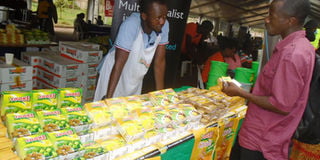Pick more from your bananas

Owobuhinza has curved a niche in value addition by processing bananas to end up with porridge flour. Photo by Fred Muzaale
What you need to know:
- Bananas can be used in biscuits, sweets, wine, beer and sauce.
- They also make good porridge. Banana value addition can be done on the farm using simple methods, writes Fred Muzaale
Banana is one of the main staple foods in Uganda and it is estimated that at least 10 million people feed on bananas as their main food in the country.
According to estimates, more than 10 million tonnes are produced every year. However, there is a lot of wastage of the banana as many farmers cannot store their produce for long, especially in periods when there is a lot of it on the market.
Bananas are highly perishable and have a very short shelf life (they ripen in days), which forces farmers to sell them off at a giveaway price once they are mature and harvested.
Value addition
Banana fruit is a horticultural commodity that can be processed and preserved to expand its marketing value.
Various processed banana products have already been developed, such as sun-dried banana and banana crispy.
A new product with a potential commercial value is the banana flour made from fresh and ripe banana.
As such, President Museveni, in 2005 set up the Presidential Initiative on Banana Industrial Development (PIBID), under which a number of confectionary products are being manufactured from bananas.
According to Wycliffe Owobuhinza, a sales manager at PIBID, some of the products they make from bananas include, Tooke biscuits, Tooke instant porridge, Tooke flour and Raw Tooke Flour.
PIBID has set up a processing factory based in Nyaruzinga village, Bushenyi District from where the processing of the bananas and general research is carried out.
How to make the banana products
Equipment
• Knife
• Plastic pail
• Slicer
• Plastic dryer rack
Processing Method
• Remove banana fruits from the bunch.
• Steam for about 10 minutes to decrease sticky sap, improve the flour colour, and facilitate the peeling process.
• Peel and then slice into small pieces.
• Soak in 5 per cent citric acid for about 30 minutes, then drain.
• Sun-dry on the plastic rack, until 10 per cent moisture content is achieved.
• Mill and sift.
• Package and store in a closed, dry place.
1-Raw tooke flour
Owobuhinza says this flour is mainly used for baking biscuits, cakes, daddies, high-fibre bread and chapattis.
He notes that for this type of flour, only bananas which are mature but not about to ripen are harvested.
The bananas are then peeled and chopped into pieces.
They are then placed in a solar drier for two days.
When it is dry, it is milled into flour in a grinding mill. It is then packaged. A half a kilogramme of this flour goes for Shs6,000.
2-Tooke instant porridge
Owobuhinza says in this case, the bananas are boiled without removing the peels.
However, when they are cooked, the peels are then removed and the banana is cut into pieces.
The pieces are put into a drier for two days to dry.
It is then milled and packed.
A quarter a kilogramme of this product goes for Shs3,000, while 10 kilogrammes costs Shs80,000.
This product can be consumed by just mixing the flour in hot water after which it is stirred.
3-Tooke biscuits
These are made from raw tooke flour. The flour is mixed with ingredients such as margarine, milk, salt, wheat and other spices to make biscuits.
No sugar is added when making the biscuits.
Owobuhinza says they own four acres of bananas in Bushenyi District from which they harvest the bananas. However, he says they also buy from farmers organised in groups.
Owobuhinza says when they add value to the bananas, they can get about Shs50,000 or slightly more from a fresh banana they buy at Shs15,000 from a farmer.
Challenges
Owobuhinza says although the market for their products is growing steadily, they still face a challenge of misconception from other consumers who think products from bananas are not good.
Also, sometimes there is scarcity of bananas especially during long dry periods, which forces their prices up.
Market
Most of their products are supplied to supermarkets in Kampala, Mbarara and other areas. However, they also have outlets in a number of trading centres.




